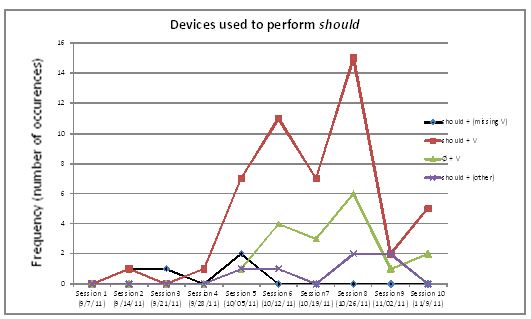|

Tanya L. Erdelyi |

Virginia K. Gillenwater Kita |
The modal system is a challenging structure for ESL/EFL
learners (Celce-Murcia & Larsen-Freeman, 1999; Master, 1996).
Difficulties experienced are attributable to the variety of forms and
multiplicity of meanings used to express modality. Modality in English
is typically expressed with modal auxiliaries, known simply as modals;
examples include should, must, might, etc. These
forms are divided into two categories: root (social obligation) and
epistemic (logical possibility). Meanings associated with the root modalshould are those of obligation, a sense of what one
is supposed to do. Epistemic meaning implies probability, what one
expects ought to occur (Master, 1996).
The natural order hypothesis of Krashen’s (1982) monitor theory
states that certain language features, such as modal forms, will be
acquired before others regardless of what is taught. Consequently,
manydevelopmental sequences(i.e., lists of ordered stages of
development) have been proposed. However, preexisting developmental
sequences for should have not been identified by
the researchers.
This article reports the results of a pilot study conducted with one
learner in her acquisition of the modal should. The
following research questions were investigated:
- How does the learner’s use of should during structured lessons differ from
performance in unstructured conversation?
- How does limited instruction impact use of should?
Ultimately, the researchers attempted to define a
developmental sequence of the learner’s acquisition of should.
METHODOLOGY
The learner, Emi, is a Japanese housewife who has studied
English with one of the researchers for 4 years, and has been studying
English informally for 40 years following her high school English
education. Emi has read many unedited versions of English language
novels. She has a sizeable vocabulary; however, she lacks speaking
fluency. For the study, Emi was asked what she would like to focus on.
She chose modals. Prior to the study, Emi was already using the modals should and have to; however, she
was aware of her errors with these forms and wanted to improve. This
study involved 10 one-hour weekly tutoring sessions, each divided
equally into two parts: free conversation and instruction. During free
conversation, the researcher did not explicitly encourage modal use;
however, questions such as “What should I do?” were used by the
researcher to create opportunities for such usage.
The instructional parts of the first two sessions assessed
Emi’s command of modals. Both researchers transcribed and verified all
occurrences of should. An analysis was done using 76
obligatory occasions of should that occurred across
all 10 sessions. Various ways Emi attempted to produce should were categorized and examined using frequency
analysis. Explicit instruction on modals for stating rules (e.g., “You
should do your homework”) was the focus of Sessions 3 and 4. In Sessions
5 through 10, modals for giving advice (e.g., “You should have a party
for your parents”)were taught and practiced using instructional
worksheets and role plays.
In Sessions 3 and 9, Emi studied the meanings of modals
(should, can, must, and have to),
the level of certainty each expresses, and the negated forms. Session 4
focused on modal sentence structure. Written homework was given in
Sessions 3 through 8, allowing Emi to prepare utterances beforehand.
These written utterances served as scaffolding during discussion-based
lessons (Ellis, 2008). In Sessions 9 and 10, Emi practiced forming
statements of rules and advice without advance writings.
RESULTS
Due to Emi’s frequent use of should, the
study centered on this modal. Emi used should and have to without prompting during free conversation in
Session 2, which shows some understanding of modal usage before
structured lessons began. She also used modals without prompting in
Sessions 6 and 7. However, during Sessions 5, 7, and 9, Emi missed
opportunities to use modals during free conversation, even with
prompting. It should be noted that the topic of conversation (e.g.,
giving advice about child-rearing) varied from session to session and
could have contributed to the frequency of modal production.
During structured Sessions 4 to 8, Emi showed a remarkable
ability to memorize and recite sentences prepared in her written
homework. In Session 8, she was asked to recall the rules from her
Session 3 homework and did so with only a few pauses and mistakes.
However, there was a considerable drop in proficiency when she was asked
to produce original statements in Sessions 5, 6, 9, and 10.
The obligatory occasion analysis of Table 1 shows a 43 percent
increase in the correct usage of should.
Table 1. Obligatory Occasion Analysis of Should
|
Session/Date |
Correct |
Total Number of
Occasions |
Percentage Correct |
|
2 09/14/11 |
0 |
2 |
0 |
|
10 11/09/11 |
3 |
7 |
43 |
Figure 1 is a frequency analysis of all uses of should, divided into four categories. Other includes five subcategories: a) should with auxiliary and main verb; b) should with inflected verb; c) negative should with verb; d) negative should without verb; and e) should
with negative auxiliary verb and verb.
Figure 1 indicates most modals were produced during Sessions 5
through 8. Sessions 1 to 4 provided fewer opportunities to use modals
due to assessment and instruction. The last two sessions involved longer
role plays during which attention was not exclusively focused on modal
production.
Figure 1. Frequency Analysis of All Should Utterances (Errors After Verb Ignored)

DISCUSSION
Unfortunately, there was not enough data from the unstructured
portions of each session, as relatively few instances of should were produced. Despite expectations, the
paucity of data made a meaningful comparison of Emi’s should utterances in unstructured conversations difficult.
A tentative developmental sequence of this learner’s
acquisition of should is described below. The
sequence was derived from the frequency analysis; other researchers have
used a similar methodology for negation and interrogatives (Cancino,
Rosansky, & Schumann, 1978). We were unable to find a
well-established sequence of should in previous
research. However, from our data, we identified the following
sequence:
- should + (missing V)
- missing should + V
- should + V
Emi stopped producing should utterances with
a missing main verb by the sixth session. Thus, she seemingly
progressed out of stage one. The remaining two stages are more difficult
to define. At all times, Emi produced utterances in the form of should + V more frequently than the form “missing should + V” (i.e., not using should before a verb even though necessitated by the
meaning and/or context of the utterance). However, in Sessions 5 through
10, Emi produced both forms. There was never a period in which she
favored missing should + V phrases over
should + V. Missing should + V was compared
with should + V utterances: in Session 5, there were
six more should + V utterances than missing should + V utterances; in Session 10, there were
three more; in Session 9, there was only one more. This unexpected
result is more striking considering that in Session 7, Emi left out should more often than she correctly produced should in clauses that were also correct. One might
have expected the opposite. It appears that, even though Emi correctly
used should more frequently by the end, she also
omitted should (as in missing should + V utterances) quite frequently.
Just as Emi’s knowledge of basic sentence structure seemed to
falter with the introduction of modals, production of correct should + V phrases may adversely affect remaining
portions of her clauses. One explanation is that the increase in other
errors is due to added cognitive demand about which modal to use
(Cummins, 1982). Perhaps another is lack of planning time to attend to
form and meaning aspects of the modal and other parts of the clauses
(Skehan, 1998).
CONCLUSION
Clearly, more work is needed to achieve conclusive results. It
was beyond the scope of this project to investigate modals other than should. Likewise, the effect of the topic of
conversation on the frequency of modals production was not examined.
Follow-up with Emi’s development of the modal should is planned. It will be interesting to see when she begins to
consistently produce appropriate should + V structures. The developmental sequence outlined above cannot
be generalized to other learners. However, it is possible that this
sequence could serve as a starting point for continued study.
REFERENCES
Cancino, H., Rosansky, E., & Schumann, J. (1978). The
acquisition of English negatives and interrogatives by native speakers.
In E. Hatch (Ed.), Second language
acquisition (pp. 207-230). Rowley, MA: Newbury
House.
Celce-Murcia, M., & Larsen-Freeman, D. (1999). The grammar book. Boston, MA: Heinle, Cengage
Learning.
Cummins, J. (1982). Tests, achievement, and bilingual students.Focus, 9, 2-9.
Ellis, R. (2008). The study of second language
acquisition. Oxford, England: Oxford University
Press.
Krashen, S. (1982). Principles and practice in second
language acquisition. Oxford, England: Pergamon.
Master, P. (1996). Systems in English grammar: An
introduction for language teachers. Upper Saddle River, NJ:
Prentice Hall Regents.
Skehan, P. (1998). A cognitive approach to language
learning. Oxford, England: Oxford University Press. | 
